This semester, I had the opportunity to participate in the Fujinomori Preservation Society’s Taiko Drumming Practice! Along with one of my fellow KCJS students, I learned the basics of how to play Taiko while also learning more about its significance in Japanese culture. Over the course of the semester, we prepared a roughly 2 minute long piece and performed it for the group, making connections with the team members and practicing our Japanese along the way. At first it was a little intimidating, but once you’re there, it gets to be very fun and rewarding. 
「Washington University in St. Louis」カテゴリーアーカイブ
Kailey Garcia: Hip Hop at FlyDanceStudio
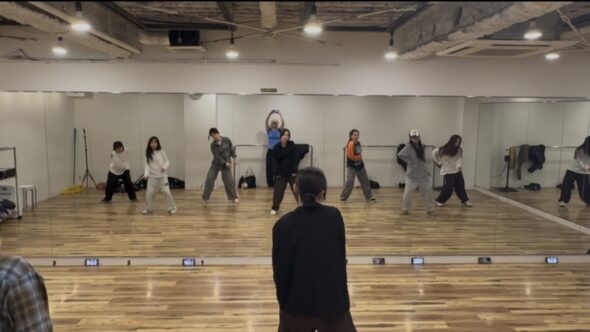
For my CIP, I took weekly hip-hop classes at FlyDanceStudio, located in Kawaramachi. I attended three classes led by Ruka先生、Nana先生、and Neo先生 on Mondays and Wednesdays. Nana’s class was beginner dance, and Ruka and Neo’s classes were taught at the intermediate/advanced level. Regardless of the indicated level, I think every class challenged me each time I attended. Over time, I began to notice gradual improvements in both areas, especially in dance retention and overall confidence. The studio didn’t really foster an environment where I could always talk freely in Japanese since the classes were structured so that the instructor could teach a whole choreo within the set time, but in the moments I did exchange conversation with my classmates and instructors, it was always encouraging. Not just with dance, but also when trying to apply language skills in real life, you’re put in situations where hesitation can hold you back from reaching your full potential. Taking classes in a language that, although I’m learning, I didn’t know the proper dance terminology, I had to learn to not be afraid to make mistakes in order to accurately measure growth. Despite the limited communication in class, every time I walked out of class with more motivation to continue studying Japanese in order to preserve the relationship I had with my instructors. Whether it’s taking a dance class for the first time or when you’re put in flight-or-fight mode, I think the most memorable moments I had in Kyoto were when I pushed myself outside of my comfort zone even if I wasn’t fully confident I could.
Kendall Owens: Calligraphy.
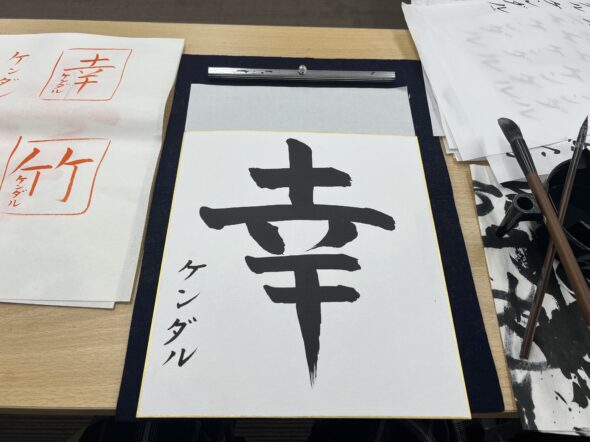
For my CIP I chose to attend 象啓書道教室 (Shoukei Shodo School) to learn calligraphy. Through my calligraphy courses, I learned the basics of shodō, how to write simple and more complex kanji, and finished the course creating two pieces on a canvas completed with my signature in katakana, and a red seal. While the early classes were very slow and awkward, I grew more comfortable with my ability to write and talk with others, and coming to the end of my classes is a bittersweet moment. I was happy to have finished the course with two pieces to take back with me, 竹 – a gift for my Aunt Take, and 幸 – happiness which I will keep for myself. If any incoming students are interested in learning Calligraphy, I would recommend it. However, if you are looking to talk with students close in age, or want to make quick progress, I would suggest a different CIP as this is not a fast paced learning experience, and the majority of students are much older. Overall I enjoyed my time at Shoukei Shodo School, and I may return for another class if I return to Kyoto.
Brandon Yoo: Sieg FC
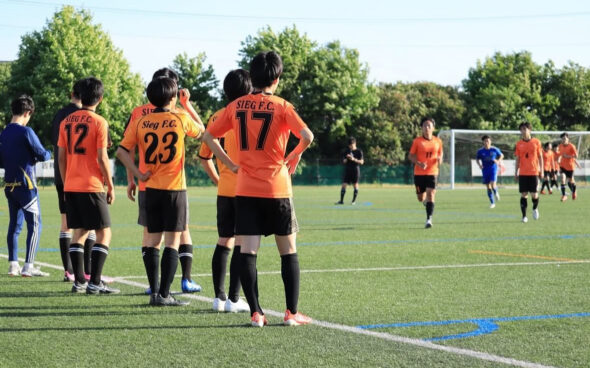 I joined Sieg FC, a student-run soccer club, at Kyoto University. The club runs 2~3 practices a week and occasionally plays against other student-run soccer clubs in Kyoto University. Everyone was very friendly and I was glad I had the opportunity to play soccer with them in Kyoto, where soccer fields aren’t as common as they are in America. I feel like it’s easy to forget to get your exercises in when you’re abroad, so this CIP was not only a good opportunity to get some exercise, but was also a nice site to interacting with local Japanese college students.
I joined Sieg FC, a student-run soccer club, at Kyoto University. The club runs 2~3 practices a week and occasionally plays against other student-run soccer clubs in Kyoto University. Everyone was very friendly and I was glad I had the opportunity to play soccer with them in Kyoto, where soccer fields aren’t as common as they are in America. I feel like it’s easy to forget to get your exercises in when you’re abroad, so this CIP was not only a good opportunity to get some exercise, but was also a nice site to interacting with local Japanese college students.
You need to bring your own equipment (cleats, socks, drinks, etc.). However, experiencing teamwork, warm-ups, and setting up practice drills were all part of the learning experience and I’m thankful for the things I was able to learn as I made new friends, participated in activities, and helped set up practice.
The club is very chill and relaxed, but all the players try their best to improve and do their best in every drill/game. However, one advice I would give is that while the activity aspect may be straight forward, the social aspect – including making friends, asking questions, and keeping contact – will be your responsibility that will not be easy. Regardless, I’m confident that anyone could have a fun time if they are willing to get involved.
Eve Koslofsky: Volunteering at Mitsuba kindergarten
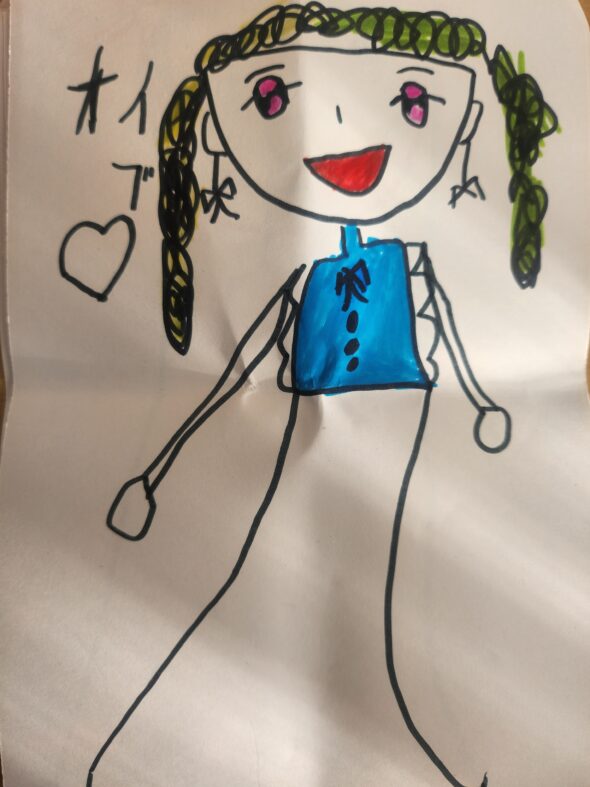
Above is a portrait drawn for me by one of the students at Mitsuba!
For my CIP I decided to volunteer at Mitsuba kindergarten. Each week I went to Mitsuba and for two hours I played with the kids and helped them out with small tasks. I feel like I learned so much from this experience, both in my language skills and my cultural understanding of Japanese schools. The kids were all so sweet, curious, and friendly, welcoming me into their classroom with open arms. The teachers were also very generous, something I was very grateful for whenever I was confused or stuck! Anyone who is interested in this CIP, I would say give it a shot – especially if you enjoy working with little kids and want to work on your speaking or listening skills.
Cindy Bu: Kendo | 京都剣清会・妙覚寺道場・武徳殿・同志社剣道部体育会
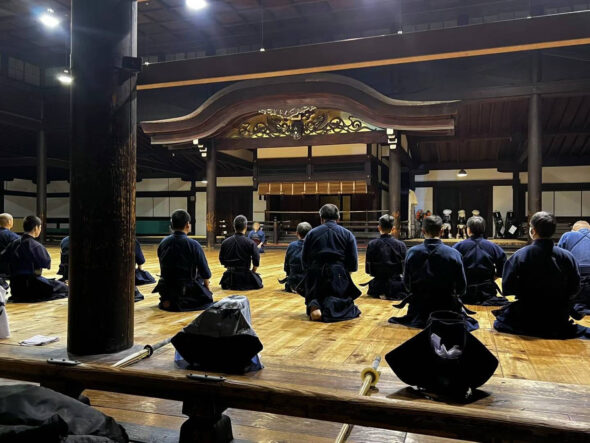
This semester, I went to different dojos to practice kendo, the sword martial arts in a number of dojos. I did not go to Doshisha Kendo Club to practice this semester yet due to schedule conflicts very sadly.
Different types of Dojos have very different vibes. 京都剣清会does not place much focus on waza training, and does fundamental basics (1h), kata (the form) (30min), and Jikeiko (1h) usually. The dojo there is very pretty (on Saturdays, I have not been to the Tuesday dojo). They will also have 飲み会 sometimes. 妙覚寺道場 is a dojo in the temple. They have practice for 1h/time, but 3times a week, spreading basics and jikeiko fairly evenly (I have not been to so many times, and you may refer to Emile’s post!). Both social dojos have strong senseis. And 妙覚寺道場 is closer to Doshisha University. 武徳殿 is open to the public, and anyone can go to the night practice there (no need invitation as said on the website). I also did not go as much, but the focus on the basics will be much less, and it is primarily focusing on 地稽古. There would be a lot of high-ranking senseis from many different dojos. 同志社剣道部’s practice is less of instruction but has more freedom to practice the skills you wish. Normally, we do the warm-up, 素振り, 切り返し, and some fixed pattern training together, and we are left off to do 自由稽古, (and 地稽古 shortly in the end). It requires more dependence on oneself, and the training is definitely much more demanding.
I would say that the Spring semester is relatively hard for being able to practice in 同志社剣道部 Doshisha Kendo Club (solely) and the fall will be much more doable. Practice after the winter break for Doshisha starts in mid-February, while our spring semester begins in the head of January. In addition, most of the practices during the Japanese students’ spring break are in the morning on weekdays, which KCJS has Japanese classes every day in the morning. And some practices on the weekends will be canceled if there is a tournament, adding on that the 春合宿 that we would not be able to attend as we probably have class at that time (it was right after the spring break for this semester unfortunately, but if it happens right in that week, you are lucky!) . The practice in the Spring semester is in the evening, but their semester starts around April, where the program is about to get to the end. I think it might be fine if you talk to Doshisha Kendo Club only to practice on weekends, but I would also recommend adding some other practices outside Doshisha Kendo and talk to both sides!
P.S. These commentaries on dojos and the scheduling for Doshisha Kendo Club is fully based on my personal first-hand experience practicing in those dojos based on my personal situations. These feelings may be different for different people. Please only take it as ONE source of reference and ask more people about these dojos or ask for a trial training and go there yourself!
Jena Denney: Volunteering at the Food Bank
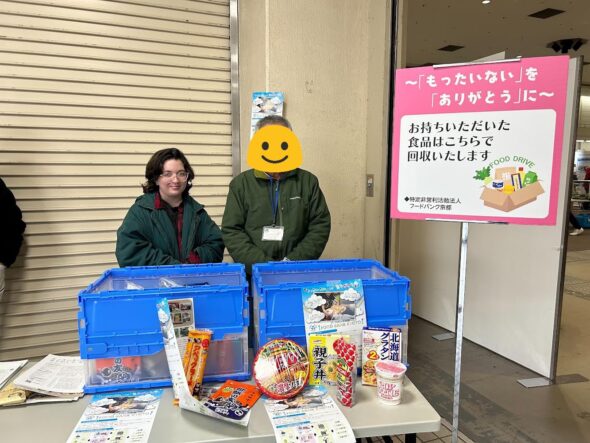
My CIP was volunteering at the Kyoto Food Bank, sorting donated food into categories by type and expiration date to get the food ready to donate. There were also events that the food bank would participate in, like having a booth at a festival, taking and giving donations, and recruiting new volunteers. I was able to get to know people from many different backgrounds, as volunteering at the food bank is a great way to connect with the local community and feel like you’re making a difference.
My advice to incoming students who want to do volunteer work or work with the Kyoto Food Bank would be to learn vocabulary that you think you might use while you’re working. For example, at the food bank, it’s important to know words like “expiration date” and the words for various foods that would be relevant and important for communicating with the other volunteers. Speaking of, it’s also important to take every opportunity you can to get to know the other volunteers and attend any special events that your volunteer work may offer! These events help give you a chance to get to know people more deeply and really engage with the community.
Nadia Perdue: Participation at Kyoto University Choir

This semester I participated in the Kyoto University Choir for about 2-3 times a week, 2.5 hours per rehearsal. On Mondays, the upper and lower voices would hold rehearsals separately, but Wednesday and Friday rehearsals were co-ed. Most of the songs we sang were entirely in Japanese, most of which I had not heard of before joining.
I have been in several vocal groups over the past few years, but this was a completely new experience. Aside from the language barrier—such as learning completely terms for music-related terminology that I was familiar with in English—the cultural differences were a completely new playing field. We take our shoes off before entering the ensemble room, clean up when we are done, and tell our fellow singers 「お疲れ様です」at the start and end of rehearsal. Moreover, at the beginning of rehearsals, not only did we do vocal warm-ups, but physical warm-ups, 体操, as well. For about 20 minutes, our ensemble dedicated time to doing anything from a few sets of squats, to full-on core exercises. We also did a few interactive warm-ups, as well, which encouraged me to break out of my shell and collaborate with my fellow singers. It was a wonderful experience getting to combine my love for music with my passion for learning more about Japanese language, Japanese music, and Japanese culture!
Even if you do not have any musical experience, I would certain encourage you to join the ensemble. Everyone was very welcoming to singers of all skill levels, and if you have any questions about anything, ask. Many times, I would feel embarrassed to ask a fellow singer on my part a question like, “What’s this musical concept called in Japanese?” However, as I bonded more and more with the people on my part, I realized that there is nothing wrong with asking questions. Once I understood this, I had a much more enjoyable experience, and learned so much in the long run.
Yue Ma: Volunteering at Elderly Activity Center
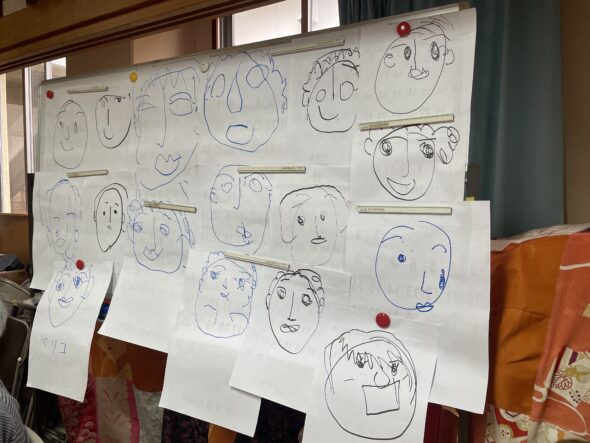
This semester I’m continuing to volunteer at the Elderly Activity Center. Similar to last semester, I go every Monday to help coordinate the 生きいきサロン. Most days I get ~20 minutes to lead a fun activity related to Chinese culture, but there are also days when I do more assistive work such as moving chairs, checking in on group activities, o just chatting with obachans. This semester I’m also taking advantage of my CIP to conduct independent research on aging in Japan, and I had the chance to talk more in-depth with several obachans participating in the 生きいきサロン. Partly because of that, I’m able to build deeper relationships at CIP and feel like I’m more welcomed and accepted there. I would highly recommend anyone interested in social work or working with elderly people to volunteer here. The staff are amazing and always supportive of my project, obachans are sweet and passionate about talking to young people, and the center seems to be pretty short of hand. For students who are not as nihongo jouzu yet, don’t be afraid of going out of your comfort zone, you will be surprised by welcoming and understandable people are. Even though talking to obachans with strong kansai accent felt so daunting initially, my mastery of the dialect has improved so much over the two semesters of interacting with them.
El-Ghannam Rashad: Volunteer at Nishijin Child Care Center.

For my CIP I volunteered at a 児童館 (jidoukan) once a week. It’s like a daycare for children to go to after school, ranging in children from ages of like 6 to older elementary schoolers. As a volunteer I get to play with the children, and make sure nobody gets hurt.
I greatly enjoyed my time here as a volunteer, every week I got to practice listening and talking as I played along with the children. I was surprised how much I could learn from them, one kid even taught me how to play shogi. Though at times it could very loud, and a lot of things may be difficult to understand. So I definitely recommend learning about the Kyoto dialect early on.
For those who are thinking about their CIP coming in, I would greatly recommend volunteering in a Jidoukan. The children are usually sweet and aren’t yet shy of foreigners and are in fact the opposite, greatly infatuated with how u look. And even if you can’t understand them or they can’t understand you at all times, they will still love talking to you. It’s perfect for those who may feel easily embarrassed about speaking mistakes, as the children don’t really care and there’s nothing to be embarrassed about. And for CIPs in general, the sky’s the limit. Go and find something you want to do or try something new.
